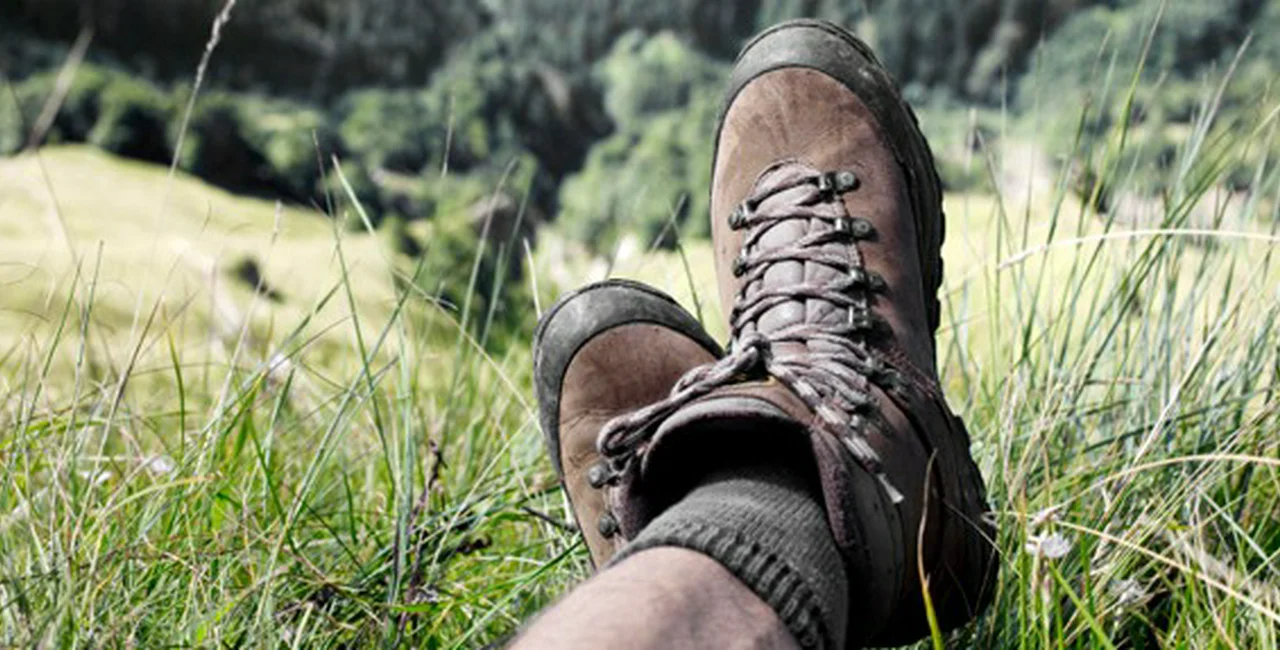The Czech Republic provides many opportunities for hiking. Low mountains, rolling hills, forests, and an abundance of castles offer any trip idyllic scenery. As a plus, the tracks are usually well-marked, and a pub or restaurant is never too far away.
Tradition of Hiking
The tradition of hiking goes back a long way. The Czech Hiking Club (Klub Českých Turistů), or KČT, was established in 1888. Before that there were at least two other groups, Sokol and Národní Jednota Severočeska (The National Union of North Bohemia), which came together to form KČT.
Following the formation of Czechoslovakia, hiking experienced a steady increase in popularity. For example, in the first five years of the existence of the club, now renamed Klub Československých Turistů or KČST, membership rose from 5,000 to 60,000. The number of people in the club increased to 100,000 by 1938. And this was not the only club operating in this period. Pohorská jednota Radhošť and Svaz dělnických turistů are two other examples.
Under communism, hiking was apparently discouraged, at least according to this article. However, explore any of Prague’s second-hand bookstores and you will find old communist-era hiking maps, so it would seem that even in this period the pastime could not be stifled.

Markers and what they mean
One of the contributions KČT has made to hiking is the use of colored markers: red, blue, green, and yellow on a white background. Friends and associates have speculated as to what the colors of the trails actually mean. According to Karel Markvart from KČT, the main reason for the different colors is ease of identification. It would be pretty confusing if all the trails were marked red, for example.
He did add that, generally, the blue and red trails are for longer main trials and the yellow and green connect them. At present there are over 40,000km of trails, of which 200 to 400 are changed annually. These changes appear in the new editions of the maps. Apart from the more well-known horizontal bands, there are other markers to indicate lookouts or the end of the trail. These can be found here.
Maps and how to read them
Corresponding to the marked trails are the ribbons of red, blue, yellow and green snaking over the maps produced by KČT. These hiking maps are in the scale of 1:50,000, and pretty easy for even a novice to follow. It is a matter of just following the route and looking for the markers as you go. The scale of the map is such that landmarks can be clearly shown.
At present there are 98 maps for the Czech Republic and surrounding regions. If the titles of the maps are unfamiliar, then this overview should help you find the maps for the region you want.

Other Signs
The marking trails are not the only symbols that you want to familiarize yourself with on the maps. The maps also show you camping grounds (a little red tent) and places to stop for a bite or a drink (a small red rectangle with a flag coming from one of the top corners).
Where to Buy Maps
The KČT maps can be picked up at most larger books stores, such as Kanzelsberger or Palác Knih. They retail for 80 CZK.
For a wider range of maps, visit Kiwi Bookstore at Jungmannova 23. Apart from maps they also sell travel guides. As a specialty travel bookstore, you know you can get good advice.
Tips
So you don’t have to fork out for a book, we’ve put together a list of some of the more popular trails with something to suit everyone, from the weekend warrior to the wee ones in your family.
Beroun Region
If you´ve never been hiking before, this area is a good place to start. Very accessible from Prague, you can visit Karlštejn and the former quarries Velka Amerika, Malá Amerika, and Mexiko (now filled with water) all within a day. There is also a decent pub called Na Růžku in the village Mořina.
Czech Hiking Club Map: 36
Czech Paradise (Český ráj)
Located north of Prague, this region is synonymous with hiking. Natural attractions include the labyrinthine rock formations of Prachovské skály, and Drabské světníčky, a rock city allegedly the haunt of bandits. The region’s famous historical landmarks are, for example, the ruins at Trotsky or the medieval Kost. The proximity to towns such as Turnov ensure there are plenty of places to eat and stay. The Sokol in Malá Skála do a good beef goulash.
Czech Hiking Club Map: 19
There is also a downloadable map.

Krkonoše National Park
Visiting the Krkonoše Mountains gives hikers a chance to visit the highest peak in the Czech Republic. The Labe, among other rivers, springs from here. Since the mountains form a natural border between the Czech Republic and Poland, crossing them lets you visit our northeastern neighbor. If you want to guarantee a good view, go in summer; the only problem is everyone else may have the same idea. Louční bouda is a popular place to stop for a refreshments on the way to Sněžka.
Kokořín Region
As with other regions, there are places here of historical interest, such as the castle Bezděz, where Václav II was imprisoned as a child, or the well-preserved Houska, named after a baked good. The city of Mělník, which is found where the Labe and Vltava meet, is wine town. It is also the location of another ossuary.
Macha’s Region (Machův kraj)
The poet Macha was a keen walker, and his famous work, Maj, was inspired by a story he was told while visiting the region, which is quite near Czech Paradise. Such is his connection with the region that it is now named for him. On the website you can find many tips for walking trips which take in the romance of the region.
Czech Hiking Club Map: 15
Lada’s Region (Ladův kraj)
Another region associated with a famous artist, though this one might appeal more to the youngsters. Josef Lada, famous for illustrating Švejk as well as for his creation the Tomcat Mikeš, grew up in the Village Hrušice, south of Prague. In homage to Lada, local villages have formed the Lada region. They offer a number of tips, most of which are quite short. These paths will exercise the kids and let them know more about some popular Czech children’s characters.
Czech Hiking Club Maps: 37 and 40
Czech Switzerland (České Švycarsko)
We´ve mentioned this area before, so we´ll just keep it brief. There are good opportunities for hiking with some great views. On the German side, there are good opportunities for rock climbing.
Beskid Mountains (Beskydy)
This mountain range starts in the southeast of the Czech Republic, and offers many good hiking opportunities. Attractions include Lysá hora, the highest peak in the Czech part of the range, and traditional wooden churches. It is also claimed that a handful of bears venture into the region – though this is only an attraction for some. Lovers of blueberry dumplings should try the ones from the restaurant at Pustevny. They don´t even use the diminutive for it; they call it borůvkový knedl.
National Park Šumava
It is hard to sum up this region in a few short lines. A place of gentle hills and the oldest forest in the Czech Republic, Šumava is a place to go when you want to get away from it all. The area is the habitat of a small group of lynxes, which are rare in the Czech Republic. This is definitely a place that deserves a longer trip.

Events
One of the appeals of hiking is the solitude and the quiet. However, it doesn’t have to be. KČT organizes a number of events throughout the year. As you will see there are many events through the spring and summer.
Some of the more famous events include:
The annual Prague to Prčice. Though the full distance is 70 km, it is usually broken into sections.
Strakonice 100, so named because the total distance is 100 km over the three days. For further information, check the contact in the link.
At the moment, KČT doesn’t organize events especially for English speakers. However, given that many Czech people speak English, you will feel welcome. And they no doubt will be keen to show off parts of the country that are not so familiar.
Hiking Badges
So that you don’t finish tour walk empty handed, many hiking spots sell hiking badges, the so-called turistické známky. While the translation on this link is not the best, it gives you the idea. These are small wooden discs with the place name and an image burned into it, and you can collect them.
So what are your experiences and recommendations?
Related article: Dos and Don’ts: Camping












 Reading time: 7 minutes
Reading time: 7 minutes 


















